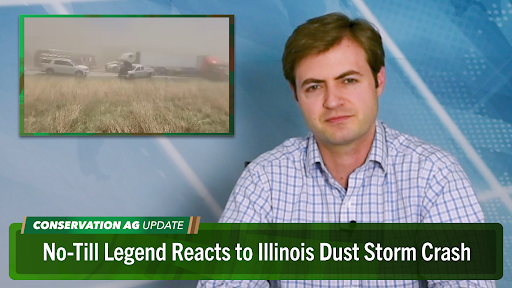In this episode of Conservation Ag Update, no-till legend Randall Reeder shares perspective on the dust storm crash in Illinois that was caused by extreme winds blowing dirt from tilled fields. We also cover the significance of the agreement between Case IH and strip-till equipment company AGuru Machinery.
The episode also features a trip to the farm of renowned no-tiller Tony Peirick as he plants green into cereal rye. The longtime no-tiller shares the benefits of planting green and explains the how’s and why’s behind making a comfortable transition into the practice. Mackane Vogel checks in with a tool to evaluate cover crop incentives, John Deere showcases groundbreaking precision technology, Tom Barcellos blazes the trail for strip-till & no-till in California and Ohio no-till expert Les Seiler finds a creative solution to his erosion issues.
This episode of Conservation Ag Update is brought to you by Saddle Butte Ag Bio Till Cover Crops.
Bio Till Cover Crops, a pioneer and leader in cover crop seeds, represents a complete lineup of seeds suitable for use in diverse soil types and growing conditions. Our focus on cover crop and regenerative forage seeds sets us apart from suppliers invested in other markets. Bio Till Cover Crops is dedicated to the expansion of the cover crop market by offering a superior, proven product matched with agronomic support from our outstanding team at a fair and competitive price point.
TRANSCRIPT
Jump to a section or scroll for the full episode...
- No-Tillers React to Dust Storm Crash in Illinois
- Case IH Partnering with AGuru Machinery
- Planting Green Tips & Advice
- Researchers Develop Cover Crop Incentive Organizer Tool
- Ahead of the Curve
- Farmer Spotlight: Tom Barcellos
- Photos of the Week
No-Tillers React to Dust Storm Crash in Illinois
7 people lost their lives in a massive crash involving over 70 cars along a 2-mile stretch on Interstate 55. The crash was caused by excessive winds blowing dirt from recently-tilled farm fields, which lead to zero visibility, according to Illinois State Police. No-Till Innovator Randall Reeder shares some perspective on what we can learn from the incident.
"One of the main lessons we need to learn from this terrible accident and episode is the cost of erosion. Now in the Midwest, most of our erosion comes from water erosion, rain storms. And the loss in soil, the loss in our best topsoil, the losses of nutrients and fertilizers that go with topsoil really adds to the cost of farming every year for our corn belt farmers. It's an amazing expense. We need not to lose sight of that cost to farmers as well as the cost to society as a whole."
Case IH Partnering with AGuru Machinery
Big news in the strip-till world — CNH Industrial, parent company to Case IH has entered into an agreement with AGuru Machinery, a strip-till company based in Congerville, Ill.
"We have always said, 'different isn't always better; better is always different,' and we knew this technology partnership would result in continued research and better technology for AGuru and Case IH customers," AGuru president Bill Preller says.
As Ag Equipment Intelligence has reported in the past, these types of partnerships can lead to acquisitions down the road, as was the case with CNH and Miller sprayers.
Planting Green Tips & Advice
How many of you are planting green into cover crops this year? This conservation practice involves no-tilling into a living cover crop and then terminating the covers to allow the cash crop to thrive.
Let's head out to Watertown, Wisconsin, where no-tiller Tony Peirick has been planting green into cereal rye for a long time. He started with soybeans over a decade ago and corn about 8 years ago. Tony — what advice would you give to people who are planting green for the first time or thinking about trying it next year?
“It’s not hard to do. I got a couple calls this spring from guys who are afraid of it. Plant green and just terminate afterwards. The glyphosate will terminate cereal rye very easily and it will decompose, break down and give nutrients back to the corn as its growing in late summer.
“Everybody is kind of afraid of it, but it’s the way to do it, it’s the way to plant. A lot of times you can plant sooner in the spring because the ground will be good and mellow, and it will plant nice with the root structure of cereal rye. It has an aggressive root structure, so the soil is really mellow.
“And on this field here, we’re dairy farmers, so we put 8,000 gallons of manure on in the winter time. Cereal rye didn’t grow as good as it did other years, but it’s a good crop and sequesters the nutrients we need to keep a living root in the soil, and keep your biology alive. You have to feed your biology.
Q: You were just showing me, the earthworm activity here is unbelievable! Explain that – when you’re seeing that much earthworm activity, what’s that telling you?
“It’s telling me we’ve got good biological activity. Earthworms are part of your biology, along with fungi and everything, they all work together in the soil. The earthworms go down and create channels that help infiltrate water, and bring nutrients back up. The earthworms bring their castings or waste back to the soil surface and that’s all fertilizer.”
Researchers Develop Cover Crop Incentive Organizer Tool
Two researchers at the University of Georgia Developed a cover crop incentive tool that helps U.S. farmers find federal and state programs providing payments for cover cropping.
Researcher Maria Teresa Tancredi spoke with me for the latest episode of the No-Till Farmer podcast.
"I was doing interviews with farmers and we were talking about several different things, both farmers that use and don't use cover crops. And one of the things that I noticed is that across the board, sometimes, no matter how long they had been using cover crops, there was a lot of confusion.
What kind of financial incentives are out there for farmers in trying to support them in their use of cover crops? I noticed that sometimes farmers were not aware that there were programs available to them, or if they were aware that the programs were available, they were usually showing some level of frustration because the information around the programs was not clear enough.
Last fall, I had decided to do an independent study with a professor at UGA. His name is Dr. Nicholas Bassinger. He's our weed specialist at the University of Georgia. And I wanted to do that study to learn more about the agronomic side of cover crops so that I could better understand what farmers were telling me, and what worked and didn't work on their use of cover crops."
And I decided to use that time to create a very basic version of this tool. And so what I did was basically. Look at federal and state programs that support cover crop adoption through different kinds of financial incentives and try to summarize their main points so that there could be one central place that farmers could land on and start getting a better idea of what's out there for them. So that's where we came up with the idea."
The resulting tool is this spreadsheet that organizes the incentive programs by federal, region and state.
It currently lists information about programs available at the federal level and in Iowa, Ohio, Missouri, Georgia, North and South Carolina, Maryland, Pennsylvania and Vermont.
Ahead of the Curve
For today's Ahead of the Curve Segment, John Deere gives us an up-close look at some brand new precision technology.
It was an action packed day at the company's new demonstration farm in Austin, Texas.
You’re looking at autonomy in action. Autonomy senior product manager Joe Liefer, from his phone, starting a driverless 8410R tractor with a 2430 chisel plow attached. It’s an easy in-field activity to automate, though this application doesn’t have much value for conservation-minded farmers.
Elsewhere in the field, See & Spray Ultimate, Deere’s smart sprayer capable of spot-spraying weeds among growing crops, was spot spraying on fallow ground at its max speed of 12 mph. Designed by Blue River Technology, the 120-foot boom has 36 cameras attached.
And here’s our first look at a new planter performance upgrade called FurrowVision. It mounts onto row units and brings the eyes of the operator into the furrow. Jesse Haecker shows us how it works.
“What you see here is our Furrow vision product. It’s made up of cameras, lights and a laser. We’re using those components to be able to identify depth. You can get a live video feed of inside the furrow from the cab. On Gen 4 display you can see seed depth. From a customer’s standpoint, not only do they get eyes into the furrow and look, but the first measurement that we’re doing with that technology is to give them an indication of depth so they have an idea if I need to get out of the cab and make adjustments on the machine.”
FurrowVision is set to hit the market in 2024.
Farmer Spotlight: Tom Barcellos
Meet Tom Barcellos. The Tipton native was the first in his area to move away from the plow when he started no-tilling 26 years ago. Now he estimates 60% of all corn production in his neck of the woods is grown under reduced tillage practices.
Today, he no-tills small grains and strip-tills corn for silage, mainly producing feed for 2,000 cows across his two dairy operations. Barcellos says strip-till has proven to be the more practical option in his region’s hot, dry climate. Top benefits include increased planting flexibility and better water infiltration. The self-proclaimed equipment junkie shows us the tools that help make strip-till work on his farm.
“It’s something that works well here. We use RTK to make sure everything is on the mark. The GPS equipment has been invaluable in trying to make this work just like anybody that runs this kind of equipment understands.
“It was big in the Midwest, came to California out of necessity. Roundup ready corn made our process work much better because since we irrigate, we end up with more weed pressure because we don’t do a lot of the residual top planting that happens in other areas.
“We run two different types of strip-till bars here in our operation. We have the Bigham bar here in the front. You’ll notice it has the coulter. We’re running dual shanks for the different types of soil. We have our wavy coulter that breaks it up, and we have a pack wheel in the back. We use this on tougher soil that doesn’t have as much organic matter or a little more alkali style because we’re dealing with something that needs more tillage in a strip-till situation.
“The bar that we’ve run for over 20 years is the Orthman 1tRIPr. You’ll see it’s pretty simplified. We didn’t have to run row cleaners or anything. Just our shank and wavy coulters in the back, and we don’t run any kind of compaction or anything in the back because the soil tilth is better in those areas and this is adequate to getting the job done. This has been our primary strip-tillage bar for many, many years.”
Tom says strip-till and no-till have also helped his family overcome labor challenges, skyrocketing fuel costs and strict water regulations in California.
Photos of the Week: Two-Stage Ditch Reduces Erosion in Northwest Ohio
Check out Fulton County, Ohio, no-tiller Les Seiler showing off a two-stage ditch he built with help from the Nature Conservancy and his local Soil and Water Conservation District. The ditch has drastically reduced erosion, slowing water down by nearly 10 mph as it flows through during heavy rainfall events. It also doubles as a pollinator habitat.
Seiler recently received the American Soybean Association’s 2023 National Conservation Legacy Award for his sustainable crop production methods and dedicate to improving the land for future generations.
Have an interesting photo or video from your farm? Or a story you’d like us to feature on the broadcast? Send me an email at Nnewman@lesspub.com.
And that will wrap things up on the first edition of Conservation Ag Update. Until next time, for more stories visit no-tillfarmer.com, striptillfarmer.com and covercropstrategies.com. Thanks for stopping by. Have a great day!









Post a comment
Report Abusive Comment